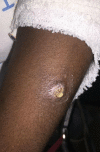SToP (See, Treat, Prevent) skin sores and scabies trial: study protocol for a cluster randomised, stepped-wedge trial for skin disease control in remote Western Australia
- PMID: 31551385
- PMCID: PMC6773324
- DOI: 10.1136/bmjopen-2019-030635
SToP (See, Treat, Prevent) skin sores and scabies trial: study protocol for a cluster randomised, stepped-wedge trial for skin disease control in remote Western Australia
Abstract
Introduction: Skin is important in Australian Aboriginal culture informing kinship and identity. In many remote Aboriginal communities, scabies and impetigo are very common. Untreated skin infections are painful, itchy and frequently go untreated due to under-recognition and lack of awareness of their potential serious complications. We hypothesise that the skin infection burden in remote Aboriginal communities can be reduced by implementing streamlined training and treatment pathways integrated with environmental health and health promotion activities, tested in the See, Treat, Prevent (SToP skin sores and scabies) trial.
Methods and analysis: SToP will evaluate a skin control programme using a stepped-wedge, cluster randomised trial design with three intervention components (the 'SToP activities'): (1) seeing skin infections (development of training resources implemented within a community dermatology model); (2) treating skin infections (employing the latest evidence for impetigo, and scabies treatment); and (3) preventing skin infections (embedded, culturally informed health promotion and environmental health activities). Four community clusters in the remote Kimberley region of Western Australia will participate. Following baseline data collection, two clusters will be randomly allocated to the SToP activities. At 12 months, the remaining two clusters will transition to the SToP activities. The primary outcome is the diagnosis of impetigo in children (5-9 years) at school-based surveillance. Secondary outcome measures include scabies diagnosis, other child health indicators, resistance to cotrimoxazole in circulating pathogenic bacteria, determining the economic burden of skin disease and evaluating the cost effectiveness of SToP activities.
Ethics and dissemination: This study protocol was approved by the health ethics review committees at the Child and Adolescent Health Service (Approval number RGS0000000584), the Western Australian Aboriginal Health Ethics Committee (Reference number: 819) and the University of Western Australia (Reference RA/4/20/4123). Study findings will be shared with community members, academic and medical communities via publications and presentations, and in reports to funders. Authorship for all publications based on this study will be determined in line with the Uniform Requirements for Manuscripts Submitted to Biomedical Journals published by the International Committee of Medical Journal Editors. Sharing results with organisations and communities who contributed to the study is paramount. The results of the SToP trial will be shared with participants in a suitable format, such as a single summary page provided to participants or presentations to communities, the Kimberly Aboriginal Health Planning Forum Research Subcommittee and other stakeholders as appropriate and as requested. Communication and dissemination will require ongoing consultation with Aboriginal communities to determine appropriate formats.
Trial registration number: ACTRN12618000520235.
Keywords: crusted scabies; impetigo; scabies; skin infections.
© Author(s) (or their employer(s)) 2019. Re-use permitted under CC BY-NC. No commercial re-use. See rights and permissions. Published by BMJ.
Conflict of interest statement
Competing interests: None declared.
Figures



References
-
- Australians Together Indigenous kinship: the heart of Indigenous society. Available: https://australianstogether.org.au/discover/indigenous-culture/kinship/ [Accessed 10 Dec 2018].
Publication types
MeSH terms
Associated data
LinkOut - more resources
Full Text Sources
Medical
